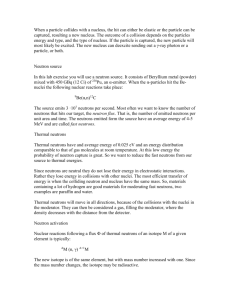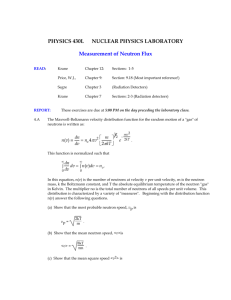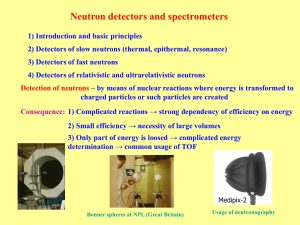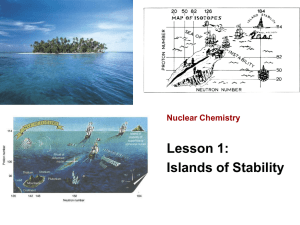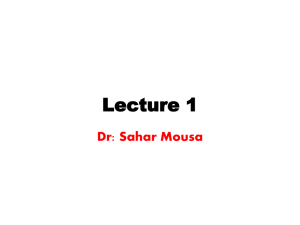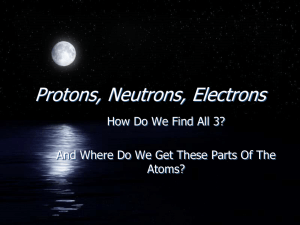Quantum trajectories of neutrons in the Earth`s gravitational field
advertisement
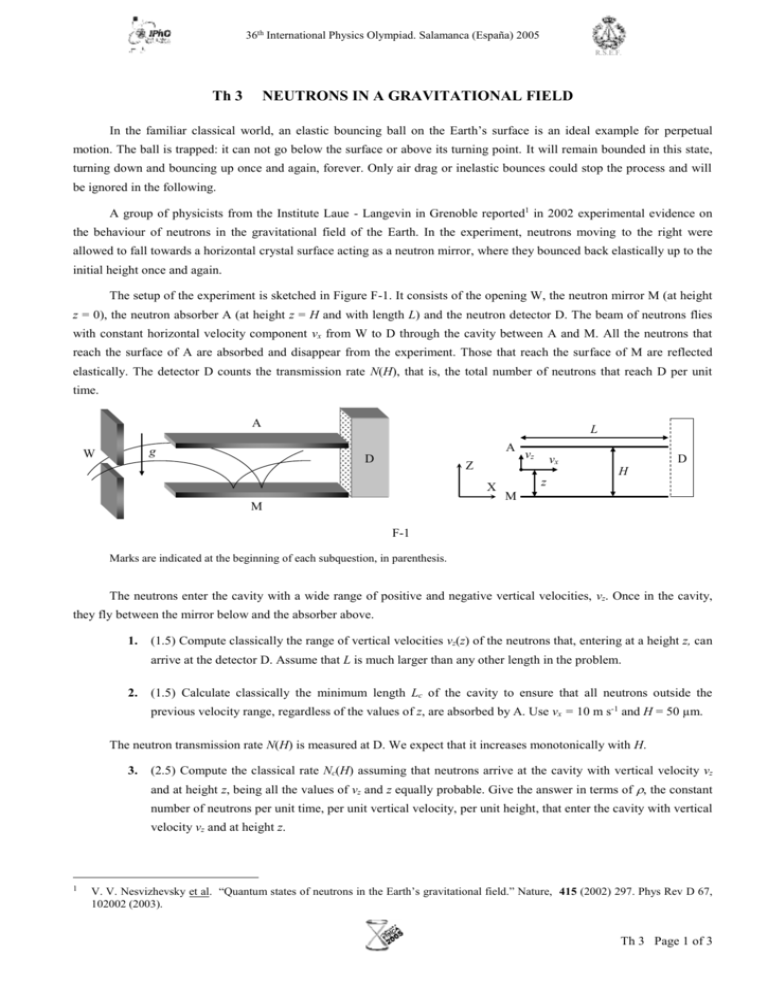
36th International Physics Olympiad. Salamanca (España) 2005 R.S.E.F. Th 3 NEUTRONS IN A GRAVITATIONAL FIELD In the familiar classical world, an elastic bouncing ball on the Earth’s surface is an ideal example for perpetual motion. The ball is trapped: it can not go below the surface or above its turning point. It will remain bounded in this state, turning down and bouncing up once and again, forever. Only air drag or inelastic bounces could stop the process and will be ignored in the following. A group of physicists from the Institute Laue - Langevin in Grenoble reported1 in 2002 experimental evidence on the behaviour of neutrons in the gravitational field of the Earth. In the experiment, neutrons moving to the right were allowed to fall towards a horizontal crystal surface acting as a neutron mirror, where they bounced back elastically up to the initial height once and again. The setup of the experiment is sketched in Figure F-1. It consists of the opening W, the neutron mirror M (at height z = 0), the neutron absorber A (at height z = H and with length L) and the neutron detector D. The beam of neutrons flies with constant horizontal velocity component vx from W to D through the cavity between A and M. All the neutrons that reach the surface of A are absorbed and disappear from the experiment. Those that reach the surface of M are reflected elastically. The detector D counts the transmission rate N(H), that is, the total number of neutrons that reach D per unit time. A A g W L D vz H X M D vx Z z M F-1 Marks are indicated at the beginning of each subquestion, in parenthesis. The neutrons enter the cavity with a wide range of positive and negative vertical velocities, vz. Once in the cavity, they fly between the mirror below and the absorber above. 1. (1.5) Compute classically the range of vertical velocities vz(z) of the neutrons that, entering at a height z, can arrive at the detector D. Assume that L is much larger than any other length in the problem. 2. (1.5) Calculate classically the minimum length Lc of the cavity to ensure that all neutrons outside the previous velocity range, regardless of the values of z, are absorbed by A. Use vx = 10 m s-1 and H = 50 µm. The neutron transmission rate N(H) is measured at D. We expect that it increases monotonically with H. 3. (2.5) Compute the classical rate Nc(H) assuming that neutrons arrive at the cavity with vertical velocity vz and at height z, being all the values of vz and z equally probable. Give the answer in terms of the constant number of neutrons per unit time, per unit vertical velocity, per unit height, that enter the cavity with vertical velocity vz and at height z. 1 V. V. Nesvizhevsky et al. “Quantum states of neutrons in the Earth’s gravitational field.” Nature, 415 (2002) 297. Phys Rev D 67, 102002 (2003). Th 3 Page 1 of 3 36th International Physics Olympiad. Salamanca (España) 2005 R.S.E.F. The experimental results obtained by the Grenoble group N(H) disagree with the above classical predictions, showing instead that the value of N(H) experiences sharp increases when H crosses some critical heights H1, H2 … (Figure F-2 shows a sketch). In other words, the experiment showed that the vertical motion of neutrons bouncing on the mirror is quantized. In the language that Bohr and Sommerfeld H1 used to obtain the energy levels of the hydrogen atom, this can be written as: “The action S of these neutrons along the vertical direction H2 H F-2 is an integer multiple of the Planck action constant h”. Here S is given by S pz ( z) dz n h, n 1, 2, 3 ... (Bohr-Sommerfeld quantization rule) where pz is the vertical component of the classical momentum, and the integral covers a whole bouncing cycle. Only neutrons with these values of S are allowed in the cavity. 4. (2.5) Compute the turning heights Hn and energy levels En (associated to the vertical motion) using the Bohr-Sommerfeld quantization condition. Give the numerical result for H1 in m and for E1 in eV. The uniform initial distribution ρ of neutrons at the entrance changes, during the flight through a long cavity, into the step-like distribution detected at D (see Figure F-2). From now on, we consider for simplicity the case of a long cavity with H < H2. Classically, all neutrons with energies in the range considered in question 1 were allowed through it, while quantum mechanically only neutrons in the energy level E1 are permitted. According to the time-energy Heisenberg uncertainty principle, this reshuffling requires a minimum time of flight. The uncertainty of the vertical motion energy will be significant if the cavity length is small. This phenomenon will give rise to the widening of the energy levels. 5. (2.0) Estimate the minimum time of flight tq and the minimum length Lq of the cavity needed to observe the first sharp increase in the number of neutrons at D. Use vx = 10 m s-1. Data: Planck action constant h 6.63 10 -34 J s Speed of light in vacuum c 3.00 10 8 m s -1 Elementary charge e 1.60 10 -19 C Neutron mass M 1.67 10-27 kg Acceleration of gravity on Earth g = 9.81 m s-2 If necessary, use the expression: 1 x 1/ 2 dx 21 x 3 / 2 3 Th 3 Page 2 of 3 36th International Physics Olympiad. Salamanca (España) 2005 R.S.E.F. COUNTRY CODE STUDENT CODE Th 3 Question Basic formulas used PAGE NUMBER TOTAL No OF PAGES ANSWER SHEET Analytical results Numerical results v z (z ) 1 2 Lc = 3 Nc(H)= Hn = Marking guideline 1.5 Lc = 1.5 2.5 H 1= μm 2.5 4 En = E1 = tq = tq = eV 2.0 5 Lq = Lq = Th 3 Page 3 of 3

